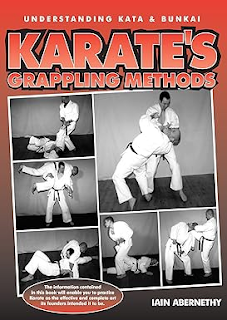At long last a credible and marvellous book on the bunkai of karate kata! And not one that just skims the surface looking for frills and thrills, succeeding to entertain but failing abysmally to prepare one for a real, in your face encounter where the winner gets to walk away (sometimes) and the loser gets anything from a plumb eye to a toe tag at the local mortuary. Rather this is an in-depth, thoughtful and thought provoking examination of possibly and probably the deadliest of arts (once fully realised); Karate. Often viewed by the uninitiated as a long range and impractical art for street self-defence, karate has not enjoyed a great rep of late - what with the new wave of realists bringing their cross-training wares to the contemporary table.
To those of us who have really studied - and I do mean 'really' studied - the art of karate, its potency (though often hidden at a glance) has always been patently obvious. When I first studied arts like western boxing, wrestling, judo, Thai etc. and when I first started to teach these arts within my (Shotokan) karate curriculum, I was more than a little surprised (and to be honest disappointed) when my peers accused me of 'abandoning karate' and teaching techniques peripheral to its syllabus. Surprised because the techniques were actually in the karate katas (but not taught on the syllabus) and disappointed because those that threw critique from the bleachers should - if they really did know their system and if they'd actually been in the arena - have known better. I spent a year training as a full time Judo student under the charismatic Neil Adams.What amazed me even more than the dextrously dangerous (and paradoxically gentle) Mr Adams was how much of the Judo syllabus I recognised (much of it for the very first time) from the karate kata. Shime-waza (chokes & strangles), tachi-waza (throws), ashi-waza (foot sweeps), kansetsu-waza (arm locks); all these wonderful and frighteningly potent Judo techniques were in abundance - though often hidden - in the katas of karate. They are a part of karate, but rarely if ever are they taught in training classes up and down the country. And I don't mean the odd kata class where a move is shown and promptly abandoned, I mean dissecting the katas, drilling the moves and allowing them free-reign in the randori or kumite. Imagine now if you were sparring in the dojo and your opponent came in a little too close and you grabbed him by the jacket and applied a cross gi strangle (Heian Yondan) and then threw him to the floor with a wrestler's body slam (Empi kata) and then perhaps followed them to the floor with a little ne-waza (ground fighting). How well do you think that would go down with your Sensei (or your opponent)? You'd be lucky to get away with a severe reprimand.Yet these techniques are as much a part of your karate as gyaku-zuki or shuto-uki. They are as much a part of your martial heritage as the bowing and the OSS-ing. It is not sacrilege that these techniques are unearthed and used, it is a sin that they are not.
I had been thinking about writing a book on bunkai - specifically the grappling aspects as contained in this book - for quite a while but I have been beaten to the post by the wonderful Mr Abernethy (damn his bones!). And I'm glad he beat me too because - though I am loathed to admit it publicly - he has done a better job on the subject than I ever could. The book is very well written, researched and presented, the pictures are clear and unambiguous and it does exactly what is says on the packet. That's why it is a pleasure for me to foreword this excellent text, and recommend the book to anyone - especially those in karate who think they know their art - out there interested in taking their art to the unforgiving, rarely practised grappling range where vertical experts become horizontal neophytes and winning strikers become unconscious grapplers.
Karate possesses a great many close range techniques but they are rarely practised. The main reason, as Mr Abernethy rightly suggests, is that close range techniques will not score points in the competitive environment. I concur completely but I would also add that it is not practised in most traditional clubs because they simply do not know that it exists, either that or they do know but are too frightened to break outside their 'classical' comfort zone. This book will greatly aid in redressing the balance and bring karate back to where it belongs in contemporary martial arts, on the cutting edge instead of dying in the water. This is a great and inspired book.
Language: English
Download: HERE

